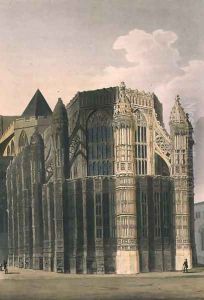





Interior of Trinity College Library, Cambridge, from The History of Cambridge, engraved by Daniel Havell 1785-1826, pub. by R. Ackermann, 1815
-
About Reproduction
Discover the allure of art with our faithful reproduction of "Interior of Trinity College Library, Cambridge, from The History of Cambridge, engraved by Daniel Havell 1785-1826, pub. by R. Ackermann, 1815", originally brought to life by the talented Augustus Charles Pugin. Unlike posters or prints, our hand-painted oil painting breathes an unique sense of depth and texture into your space. Every detail, every stroke, and every texture is meticulously recreated, paying the perfect homage to Augustus Charles Pugin and his artistic vision.
Owning this piece is more than just decoration - it's a statement of your refined taste in art. Let the vibrant colors and intricate details of this replica serve as a daily reminder of the beauty in our world. Elevate your decor and appreciate the richness of art with our replica of this masterpiece.
-
Painting Description
"Interior of Trinity College Library, Cambridge, from The History of Cambridge" is an early 19th-century engraving by Daniel Havell, based on a work by Augustus Charles Pugin. Published in 1815 by Rudolph Ackermann as part of a larger volume, "The History of Cambridge," this piece showcases the grandeur and architectural beauty of the Trinity College Library, one of the most iconic buildings in Cambridge University.
The engraving captures the intricate details of the library's interior, reflecting the neoclassical design that was prevalent in the early 1800s. Augustus Charles Pugin, renowned for his architectural drawings, meticulously illustrated the library's ornate woodwork, vaulted ceilings, and expansive rows of books, which Havell then translated into the engraving. The work not only serves as a piece of art but also as a historical document, providing insight into the design and atmosphere of the library during this period.
This collaboration between Pugin and Havell is a fine example of the synergy between artist and engraver, combining Pugin's keen eye for architectural detail with Havell's skill in the art of engraving. The publication by Ackermann, a prominent art and literature publisher of the time, further emphasizes the significance of the work in the context of early 19th-century British culture and academia.
The engraving is appreciated not only for its aesthetic qualities but also for its contribution to the documentation of British architectural history. It remains an important work for scholars studying the history of Cambridge University, the evolution of library design, and the development of engraving as an art form during the Regency era.
-
Lead Time & Shipping
When you order this oil painting replica, it typically takes 2-3 weeks to paint. If the artwork is more complex, it might need a little more time to ensure the best quality. Once it's ready, we'll send you a photo for your approval. After you give the green light, we'll ship it to you for free.
-
Return & Refund
We believe in the quality of our hand-painted oil painting reproductions, and your satisfaction is our priority. If for any reason, you are not completely satisfied with your purchase, we offer a 45-day return policy. You can return your artwork within 45 days of receipt and receive a full refund. Please note that the artwork must be returned in the original packaging and in the same condition as it was received.




















